The concluding chapter of an exploration of the use of glass in architecture…
Glass – 03
How would the city be if glass wasn’t been invented yet.. well.. we are where we are, glass is everywhere, it is not only in the windows: glass is one of my best friends since the first thing I do even before I stand up in the morning, is to put on glasses to be able to see.
Glass is in the hob when we warm up food, it is in the glasses when we drink, in many cooking trays in the kitchen. In this exact moment I am writing with the laptop laid on top of a glass table and the light come from a lightbulbs which is made of glass, of course, and the list could be endless. Glass is so abundantly part of our daily activity that we cannot easily imagine to leave without it and to try to answer the initial question can only push me, I admit, toward the field of the fiction.
Necessary and superfluous
The reasons of the existence of glass in human history are so strong that I wouldn’t dare to think a society without it and I would say instead that, for many reasons, glass is a necessary element. However, if we narrow the field of the research to the envelope of buildings, the answer could take an unexpected turn: is glass necessary in the envelope of buildings?
Actually no, it’s not. Or at least, it is absolutely unnecessary to make a completely glazed envelope, but architecture is not the art of necessity… except the fact that culture, architecture and art are a necessity and Mies’s glazed tower for Friedrichstrasse and Philip Jonson’s Glass House are a necessity (please forgive me the conundrum).
I would ask again if you allow me: is glass necessary in the envelope of buildings?
Yes, it is, absolutely! Or at least it is necessary to keep the research going on and to develop new glasses and new materials which can make buildings more intelligent.
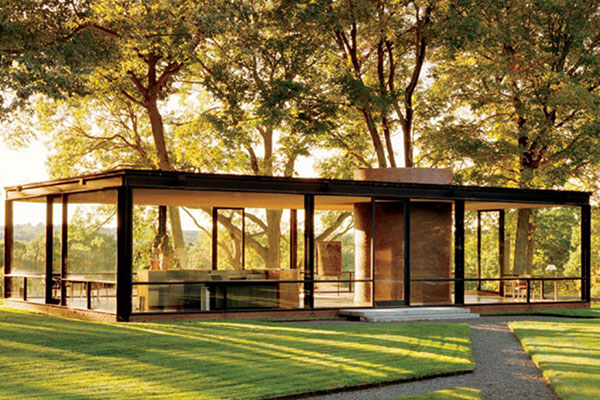
Philip Johnson’s Glass House, New Canaan, Connecticut, built for himself in 1949
Glass Research and innovation
The research in the field of the glass permitted the discovery of amazing properties that can make this very old friend become incredibly efficient and surprisingly advanced: I will mention here just a very short list of examples since this matter would require an entire dedicated essay to be properly developed.
- Glass can famously help on producing energy in different ways and the photovoltaic process is just one of the most diffused systems.
- Glass, if properly combined with other materials can become photochromic and can change its light’s transmission properties as desired.
- Glass can change colour if stimulated with electricity (electrochromic).
- Glass, combined with liquid crystals is widely used, as everyone knows, in the media field to produce high quality screens.
- Glass can be produced in very tiny, micro fibres with incredible strength when used in combination with other materials: GRG (Glass Reinforced Gypsum), GRP (Glass reinforced plastic) and GRC (Glass reinforced concrete).
- The property of glass to transport light (total internal reflection) and the capability of producing micro fibres allows us to create the (currently) fastest means of transport for information: fibre optics.
I would highlight that, unfortunately, most of these properties have been developed in other fields and are only rarely used in a building’s envelope.
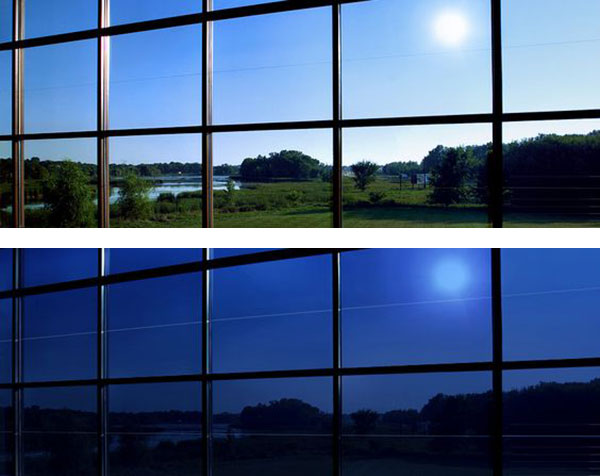
Photochromic glazing by Sage Glass (Saint Gobain)
What could replace glass?
There is a material which, for some reason, never managed to reach a respectable position in the collective imagination, but which could instead be considered as a very competitive substitute: plastic. A few specific types of plastics have a similar refractive index as glass, are stronger than glass, are sufficiently resistant to the variations in temperature, are much lighter than glass and, as the name suggests from the Greek root, all the plastics are very malleable materials to be produced.
There are many types of plastics but the ones which could most probably compete with glass are:
- Polymethilmethacrylate (PMMA) also known as Plexiglas or Perspex or Acrylic: this material offers good transparency and resistance to UV rays plus a very low thermal conductivity.
- Polycarbonate, which has a very good light transmission property and very low thermals conductivity.
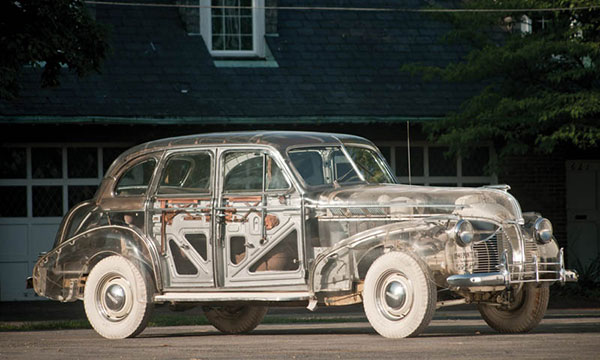
Pontiac DeLuxe Six car built from Plexi-glass, 1939 in conjunction with Rohm and Haas
I could quote many different companies and names of product that claim that their plastic is much better than glass but there is, I believe, a fundamental issue to deal with, in regard with plastic.
Plastics are mainly based on organic materials chemically transformed (hydrocarbons), and their organic origin doesn’t seem in principle to offer a very reliable performance in term of long-term durability. Will plastic last centuries as glass does? Probably not but, anyway, who wants today a product which lasts centuries?
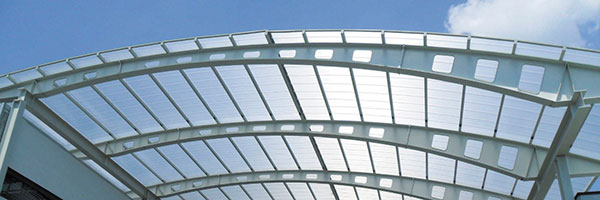
Pilkington laminated glass
A city without glass (a fictional conclusions)
Yes, you are right, I am walking around but still I haven’t answered the initial question. Let’s see..
If glass wasn’t been invented yet … we would probably use a lot of plastic, for example but, would the Kublai Kahn be interested in listening about a city made out of plastic? I don’t think so.
There could be another fictional theory: without glass all the windows will be just open holes. In this case we would have to over-dimension all the services to reach the right condition of comfort inside and I can only guess the dimension of the plants: they will occupy perhaps 70 or 80 % of the volume of a building. Would you imagine such a city and how much more energy we would have to use?
In this imaginary glassless city maybe the boundaries of science would have been pushed to look for more efficient services and today the production of energy would be more advanced and “green”.. who knows?
A city with less glass
The imaginary experiment to paint a city without glass can be pretentious perhaps, but it makes you think that we could use our technical knowledge to design more efficient building envelopes. The mission to catch the light, to maximize the views and preserve the energy are sometimes completely left to over-stressed fully glazed façades.
There are buildings which are fully designed to maximize their interface with the outside and their plans, sections and details reflect this intent: the envelope is only one of the many players dealing with the external environment.
I’d like to quote a project which could perhaps inspire us to think more deeply about strategies of making light enter a building, without resorting to a fully glazed façade. Glass is used of course, only in a very controlled way and in a respectful manner: Maison La Roche (Le Corbusier and Pierre Janneret, Paris, 1923-25).
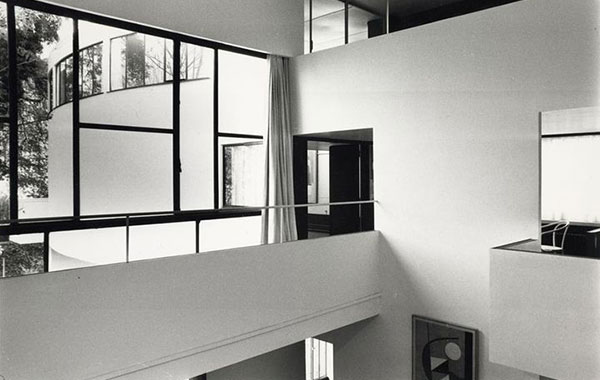
Interior of Maison La Roche by Le Corbusier and Janneret, Paris. Image by fondationlecorbusier